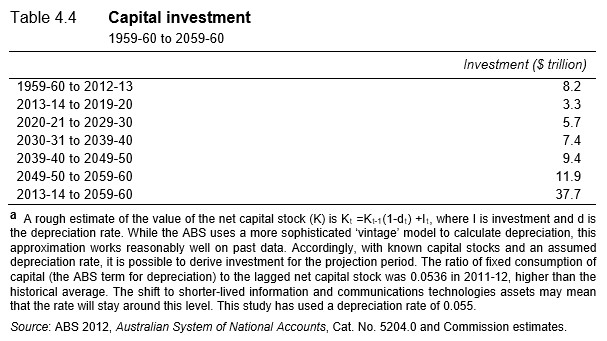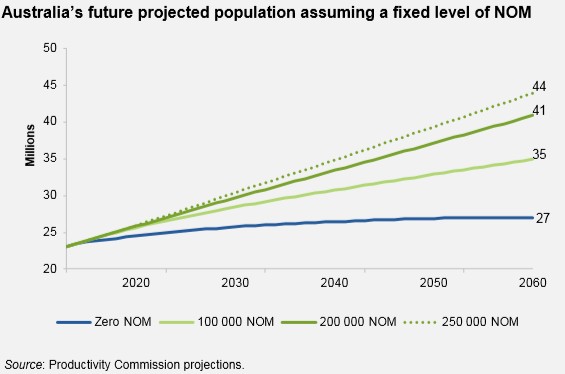Fairfax’s Clancy Yates has written an interesting piece today on former Treasury Secretary, Ken Henry’s, comments last week warning that Australia must undertake a massive infrastructure building program in order to avoid being choked by population growth:
…here’s what Henry had to say when asked to name an issue that doesn’t get the attention it deserves.
“How come infrastructure is the elephant in the room in too many conversations about the circumstances that Australia finds itself in and the challenges and so on?
“The Australian population is growing by something like 400,000 a year. Think of it: a new Canberra every year between now and the end of the century. Or, put it this way, every five years building a brand new city from scratch in Australia for 2 million people.”
“Or put it this way: building a whole new city the size of Melbourne every decade between now and the end of the century”…
“My observation in Sydney and Melbourne today, is that people already think, with very good reason, that the ratio of population to infrastructure is too high. But we have set ourselves on a journey that implies an increase in that ratio. An increase in that ratio that is associated with more congestion, longer commute times to work, increasing problems with respect to housing affordability”…
Government capital spending – money used for assets such as roads, bridges, hospitals and schools – as a share of the economy has been on a downward trend since 2010…
Perhaps the more meaningful measure is how much we’re spending on infrastructure per person. That isn’t even coming close to keeping up with the growth in our population, which is much faster than most developed countries.
…travel times are getting longer in Sydney, Melbourne and Brisbane, all of which drag on productivity…
Unless there is a rethink about our embrace of fast population growth, it all adds up to a convincing case for lifting government spending on public works. Either that, or we face the prospect of more traffic jams, more time getting to work and even less affordable housing.
All common sense stuff. However, why does everyone only focus on raising infrastructure spending? Why not also question Australia’s world-beating immigration, which is the driver of Australia’s population growth and the reason why Australia must build a new Canberra every year or a new Melbourne every decade to keep up?
Like it or not, building new infrastructure in Australia has become hideously expensive.
The Productivity Commision’s final report on An Ageing Australia: Preparing for the Future projected that Australia’s population would balloon to 38 million people by 2060 (primarily via immigration) and warned that total private and public investment requirements over the 50 year period are estimated to be more than 5 times the cumulative investment made over the last half century:

Then in its recent Migrant Intake into Australia report, the PC revised its population projection upwards to 40 million and warned that:
Governments have not demonstrated a high degree of competence in infrastructure planning and investment. Funding will inevitably be borne by the Australian community either through user-pays fees or general taxation.
Therefore, running a mass immigration program requires massive investment and costs a lot. But to date, Australia’s governments have failed dismally on this front, and there is nothing to suggest that the situation will change in the decades ahead.
The obvious solution, therefore, is to significantly scale back immigration and forestall the need for costly new infrastructure investment in the first place, especially given ongoing mass immigration is also likely to lower the welfare of incumbent residents.
The fact of the matter is that strong population growth is a policy choice determined by Australia’s immigration intake, not a fait accompli.
As shown in the next chart, which comes from the PC, Australia’s population will reach 40 million mid century under current immigration settings, some 13 million more than would occur under zero net overseas migration (NOM):

That’s a helluva lot of extra people to build infrastructure for versus a low or zero NOM policy.
So, instead of everyone hand-wringing over inadequate infrastructure investment, how about a national discussion over Australia’s mass immigration settings, which are the demand-driver causing the problems in the first place? Why not reduce immigration to sensible and sustainable levels?
And if our governments choose to continue mass immigration, where is the national plan to cope with building the equivalent of a new Melbourne every ten years ad infinitum? And how will Australia’s governments ensure that incumbent residents’ living standards will not be eroded by the associated pressures on infrastructure, housing, the environment, and the dilution of Australia’s fixed mineral endowment, which is a key driver of our wealth and living standards?
These are the threshold issues that must be asked of our policy makers as they continue our blind march towards a ‘Big Australia’.

